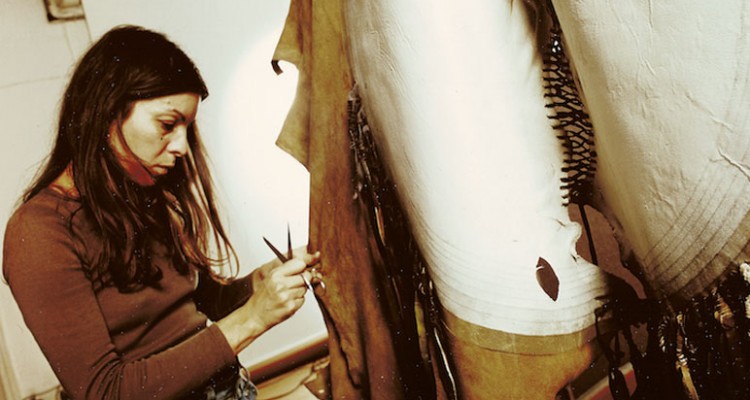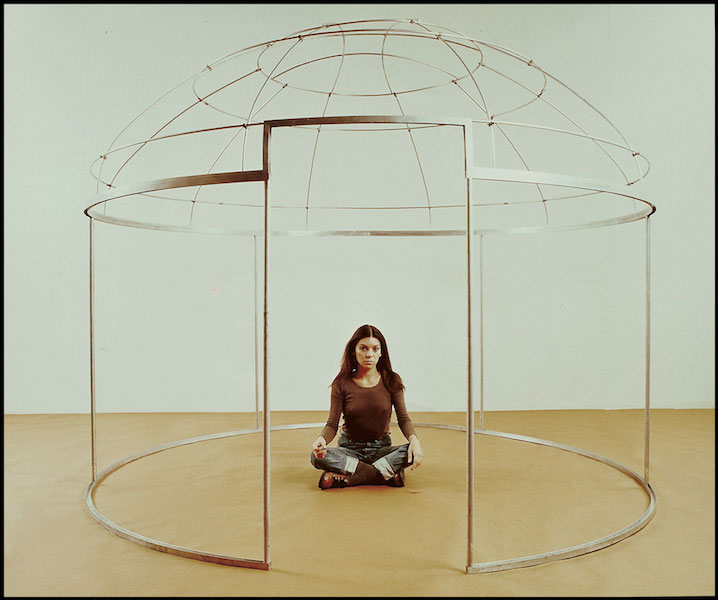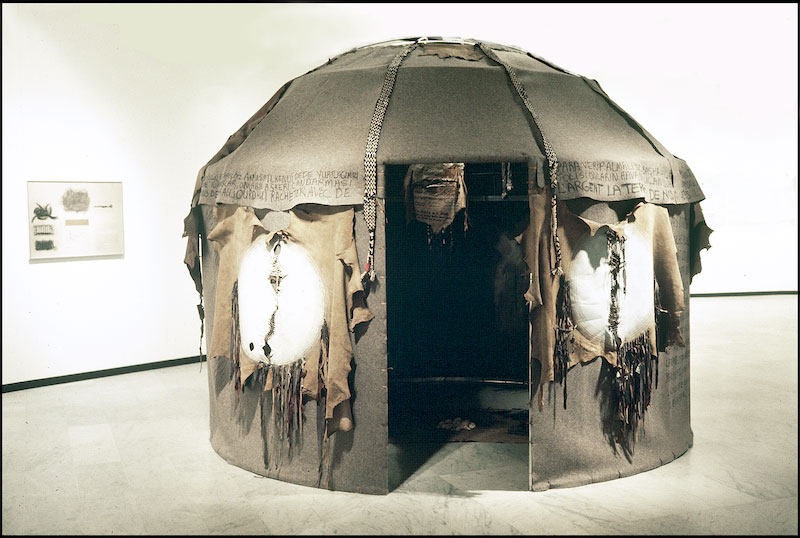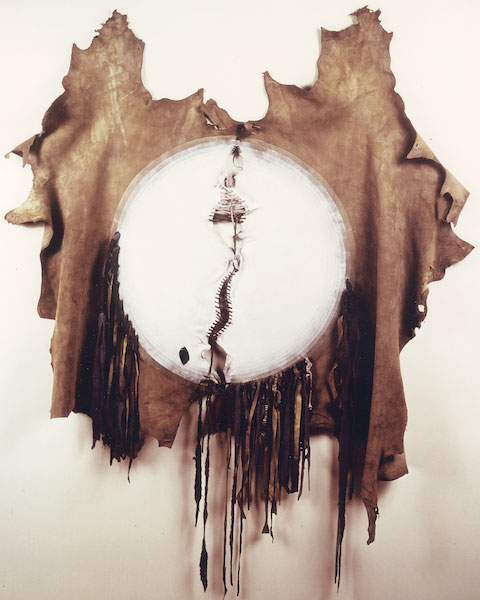 Installation view of Topak Ev (Nomad's Tent/La Yourte): A Study of Private, Public, and Feminine Spaces (1973), installation with leather, felt, paint and metal. ‘Topak Ev’ exhibition, Musée d'Art Moderne de la Ville de Paris, 1973. All images courtesy of the artist.
Installation view of Topak Ev (Nomad's Tent/La Yourte): A Study of Private, Public, and Feminine Spaces (1973), installation with leather, felt, paint and metal. ‘Topak Ev’ exhibition, Musée d'Art Moderne de la Ville de Paris, 1973. All images courtesy of the artist.
“The Woman’s Tent” is a fictitious exhibition featuring two historic works by artist Nil Yalter ― Nomad’s Tent (Topak Ev/La Yourte): A Study of Private, Public, and Feminine Spaces (1973) and Shaman (1979) – that revolves around the shamanic cultures of Anatolia. Central to this curatorial imaginary are the local traditions and rituals dating back to the pre-Islamic era, also referenced by the word “shaman” or “baksı” in Kyrgyz that gives the Baksı Museum its name. Situated in a remote village in North-Eastern Turkey, the Museum provides further context and is imagined to house this unique curatorial plot.
Nomad’s Tent, possibly Yalter’s most iconic work, stems from the artist’s 1973 visit to Niğde where nomadic communities with shamanic beliefs from Central Asia have immigrated around the 10th century. First conceived for the artist’s eponymous exhibition at ARC/Musée d’Art Moderne de la Ville de Paris in 1973 this installation is an inhabitable tent made with painted pieces of leather, and felt placed over a metal structure, mimicking the dwellings of the Anatolian shamans from long before. It bears several characteristics like an open top to welcome light into the tent as well as rugs and knitted details – often made exclusively by women and associated with perceptions of female beauty and fertility.[i] Tracing the gender roles and codes that entrap women in domestic spaces back to the ancient traditions of Central Asian communities and exploring the woman’s role in relation to migration, Nomad’s Tent marks the beginning of the artist’s long term interest in individual experiences, particularly that of women, who like immigrants and prisoners live on the margins of the society.
Accompanying this installation is a rare video piece titled Shaman, in which a female figure – Yalter herself ― whose face is obscured by a mysterious mask, free-styles to an anonymous ritualistic music of Afghan origin played from a tape. The video was recorded at one of the storage rooms at Musée de l’Homme in Paris, and the mask that the artists wears throughout the video belongs to a Turki tribe in Central Asia. Shamans have been considered as practitioners who are able to reach altered consciousness in states of trance. They transcend the physical body in order to reach spiritual entity for healing purposes. Yalter’s mimicry of the shaman can be seen as an act of symbolic subversion that exceeds hierarchies of place and social construct, traveling freely through ritual.
The Woman’s Tent, a micro exhibition with larger social and cultural questions, speaks to our inner selves through an imaginary journey back to our ancient roots. It also urges us to reflect upon the meanings of Yalter’s shamanic rituals in relation to a series of contemporary social concerns including nomadism, migration, spirituality and an enhanced attachment to nature. In this newly imagined context, the exhibition intends to explore the potentials of an artistic gesture unearthing shamanic practices of healing, helping, and protecting from life’s degenerative forces in response to the devalued state of an Anatolian land and its people today.
– Text by Guest Editor Nazlı Gürlek
Nil Yalter, Shaman, 1979, B&W video, 7’. Courtesy of the artist.

Installation view of Topak Ev (Nomad’s Tent/La Yourte): A Study of Private, Public, and Feminine Spaces (1973), installation with leather, felt, paint and metal. ‘Topak Ev’ exhibition, Musée d’Art Moderne de la Ville de Paris, 1973.

Installation view of Topak Ev (Nomad’s Tent/La Yourte): A Study of Private, Public, and Feminine Spaces (1973), installation with leather, felt, paint and metal. ‘Topak Ev’ exhibition, Musée d’Art Moderne de la Ville de Paris, 1973. Photograph by Mayotte Magnus Levinska.

Installation view of Topak Ev (Nomad’s Tent/La Yourte): A Study of Private, Public, and Feminine Spaces (1973), installation with leather, felt, paint and metal. ‘Topak Ev’ exhibition, Musée d’Art Moderne de la Ville de Paris, 1973.

Detail from Topak Ev (Nomad’s Tent/La Yourte): A Study of Private, Public, and Feminine Spaces (1973), installation with leather, felt, paint and metal.

Detail from Topak Ev (Nomad’s Tent/La Yourte): A Study of Private, Public, and Feminine Spaces (1973), installation with leather, felt, paint and metal.